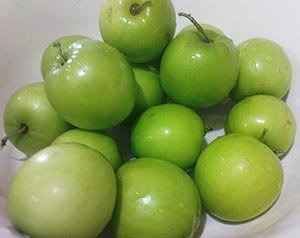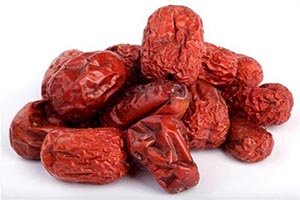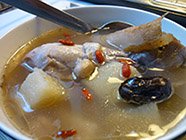Jujube Nutrition facts
Jujube, also known as Chinese red date (枣), is an attractive fruit native to China. Called by the name "Zao" (枣) in mainland China, it thrives both in the wild and in cultivated orchards across Korea, Japan, and various regions of the Middle East. The dried jujube shares a flavor and nutritional composition akin to dates, offering a rich source of energy, minerals, and vital vitamins.
Botanically classified under the Rhamnaceae (Buckthorn) family of flowering plants, its scientific name is Ziziphus jujuba.
 |
| Light green, raw jujube fruits. (Photo by-epen2c) |
The jujube tree, a deciduous species, ranges from small to medium in size, spreading out to about 5-7 meters tall. Its branches are densely covered with sharp spines. Known for its resilience, this tree thrives even in arid conditions and nutrient-poor soil.
During early summer, Z. jujuba blossoms with light green or white flowers, eventually giving way to lemon-sized fruits that adorn the entire plant by July. Botanically classified as a "drupe," each fruit contains creamy-white flesh surrounding a single hard pit, akin to apricots.
Jujube fruits vary in size and shape based on the cultivar. Ranging from 3-6 cm in diameter, they can be oval, oblate, round, elongated, or cylindrical. When raw, green jujubes are crisp and offer a sweet-tart flavor reminiscent of apples.
Left to dry on the tree, the berries transition from light green to reddish-brown. Upon full maturation and drying, the jujube fruit shrivels, developing wrinkles on its surface, similar to dates.
Harvested jujubes cater to consumer preferences, whether enjoyed raw and crunchy when light green or as dried, red berries.
Health Benefits of Jujube
In Chinese culture, both fresh and dried jujube are highly regarded for their nutritional value. They boast an impressive array of antioxidants, vitamins, and minerals, essential for proper growth, development, and overall health.
While fresh jujube is rich in vitamins and fiber, the fully ripened red berry is calorie-dense and packed with concentrated vitamins and minerals.
Jujubes contain beneficial tannins known for their anti-infective, anti-inflammatory, and anti-hemorrhagic properties, which help prevent excessive bleeding.
Fresh jujube stands out as an excellent source of vitamin C, providing around 69 mg per 100 grams, meeting 115% of the daily recommended intake. Vitamin C, a potent water-soluble antioxidant, combats harmful free radicals and aids in connective tissue synthesis and wound healing.
Dried jujube fruits are notable for their calcium content (79 mg or 8% of RDI) and iron content of 1.90 mg per 100 g of fresh fruit (about 24% of RDI). Iron is crucial for hemoglobin formation in red blood cells, determining blood's oxygen-carrying capacity.
Calcium, essential for bone and teeth health, also plays a vital role in muscle function, blood clotting, and nerve signal transmission.
Additionally, both fresh and dried jujube contain moderate levels of B-complex vitamins. Dried jujube is particularly rich in pyridoxine (vitamin B-6), thiamin, niacin, pantothenic acid, and riboflavin, acting as cofactors in carbohydrate, protein, and fat metabolism.
| Principle | Nutrient Value | Percent of RDA |
|---|---|---|
| Energy | 79 Kcal | 4% |
| Carbohydrates | 20.53 g | 16% |
| Protein | 1.2g | 2% |
| Total Fat | 0.20 g | 1% |
| Cholesterol | 0 mg | 0% |
| Vitamins | ||
| Niacin | 0.900 mg | 5% |
| Pyridoxine | 0.081 mg | 6% |
| Riboflavin | 0.040 mg | 3% |
| Thiamin | 0.020 mg | 2% |
| Vitamin A | 40 IU | 1% |
| Vitamin C | 69 mg | 115% | Electrolytes |
| Sodium | 3 mg | <1% |
| Potassium | 250 mg | 5% |
| Minerals | ||
| Calcium | 21 mg | 2% |
| Copper | 0.073 mg | 8% |
| Iron | 0.48 mg | 6% |
| Magnesium | 10 mg | 2.5% |
| Manganese | 0.084 mg | 4% |
| Phosphorus | 23 mg | 3% |
| Zinc | 0.05 mg | <1% |
| Phyto-nutrients | ||
| Catechin | 3.2 mg | -- |
| Quercetin | 1.3 mg | -- |
Medicinal uses of Jujube
In traditional Chinese medicine (TCM), both dried jujube fruit and its powder are employed to alleviate nervousness, bolster immunity against infections, and enhance digestive function.
Selection and storage
 |
| Dried jujube |
In mainland China, fresh jujube berries typically make their debut in the markets starting from July and extend through November. A variety of fresh or dried date-like berries are readily accessible in these markets.
Upon harvest, jujube fruits are sorted based on ripeness and size. Drying methods resemble those used for raisins, involving sun-drying for approximately three weeks or using commercial dehydrating machines. The resulting dried fruit can be consumed as is or further processed into juice, wine, powder, and other products.
For those seeking crunchy-textured berries reminiscent of apples, opt for fresh, light-green, full, and firm berries. Packaged dried berries are also available.
When kept at room temperature, raw, fresh berries maintain their quality for 3-4 days, while refrigeration can prolong their shelf life for up to a couple of weeks. Dried berries, on the other hand, can be stored for several months with proper care.
Preparation and serving method
Wash them in clean water, and dry mop using a paper towel. Fresh as well as dried berries can be eaten out of hand without any seasonings.
 |
| Jujube fruit, wolfberry, chicken soup. (Photo-Singzy) |
Here are some serving tips:
Fresh berries can be enjoyed just like apples, eaten out of hand.
Dry jujube can be used in a much similar way as dried dates, in cakes, tart, bread, muffins, etc.
Jujube fruit tea (대추차) is a welcome drink in Korean culture.
In Korean peninsula, tea made with dried red-jujube and ginseng tea (insam-daechu cha) is a wellness drink.
Jujube rice cake (대추떡) is another favorite sweet-dish of Koreans.
In China, dried jujube is commonly used to create jams, paste, and puree. Jujube paste and sweet pastries, including mooncakes, are traditional treats enjoyed during the mid-autumn festival.
Safety profile
Jujube fruits, whether fresh or dried, are safe for consumption by children and pregnant mothers. (Medical disclaimer).
≻≻-Back to Fruits from Jujube. Visit here for an impressive list of all varieties of fruits with complete illustrations of their nutrition facts and health benefits.
≻≻-Back to Home page.
Further reading and Resources:
United States National Nutrient Database for Standard Reference.
Dried jujube fruit-United States National Nutrient Database for Standard Reference.